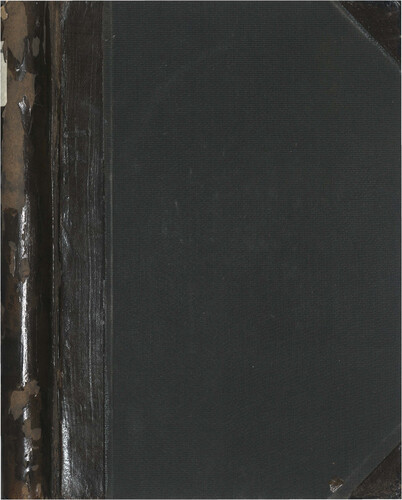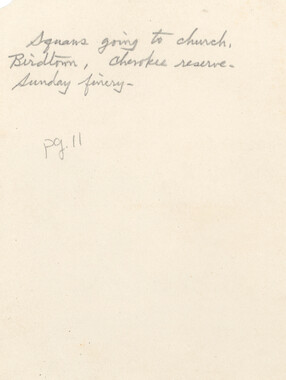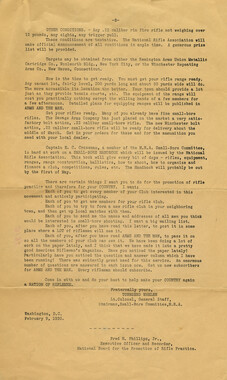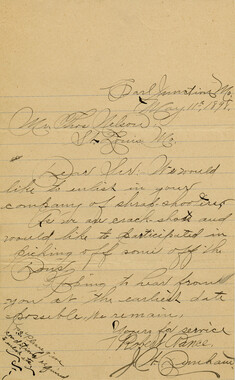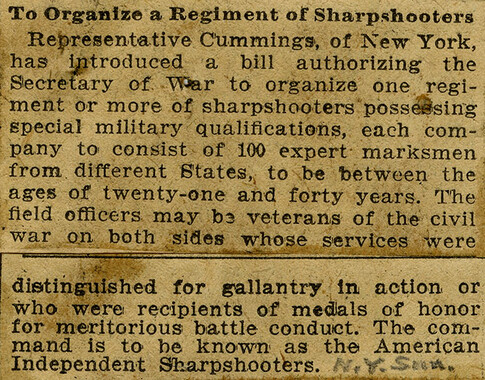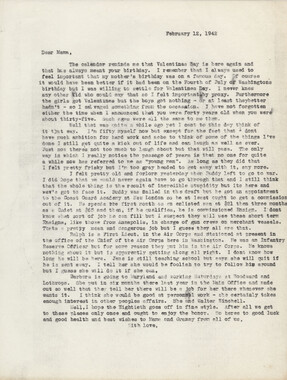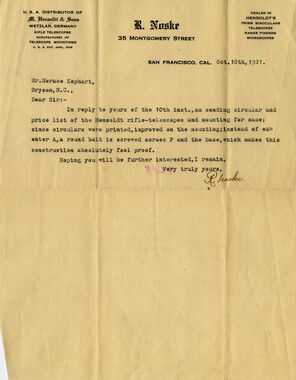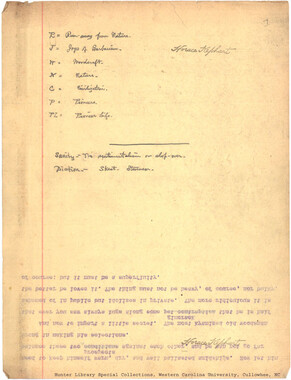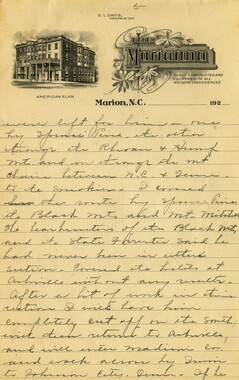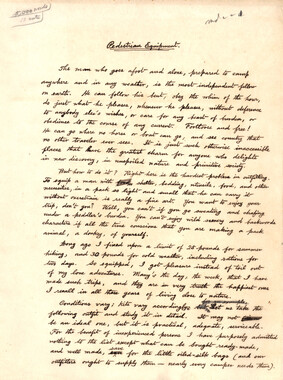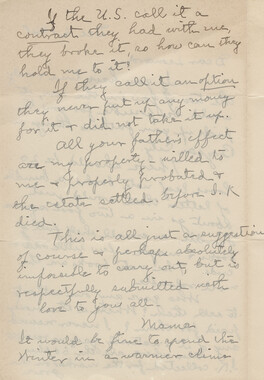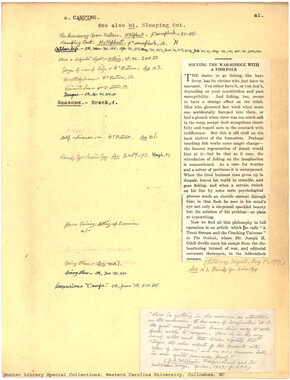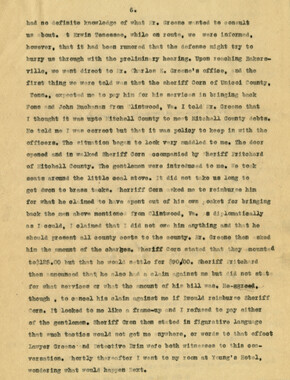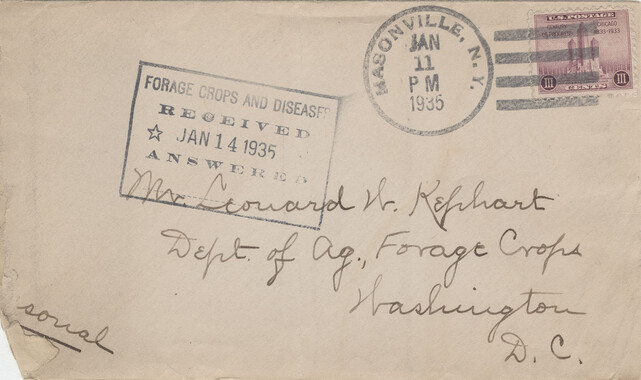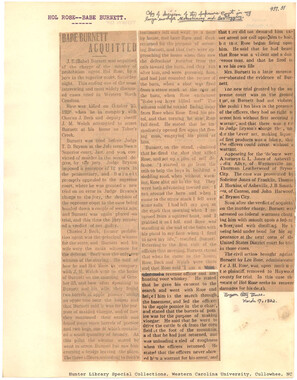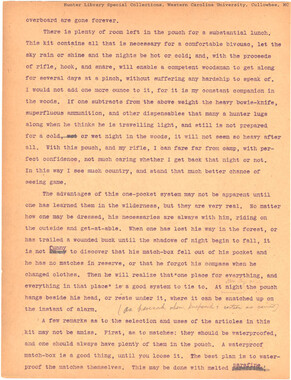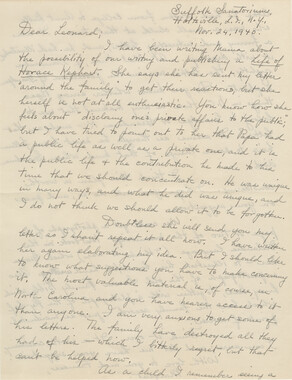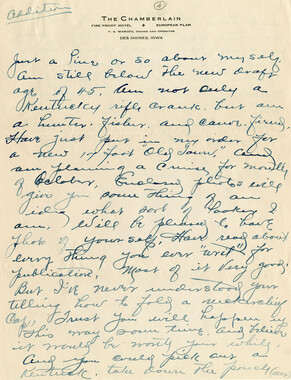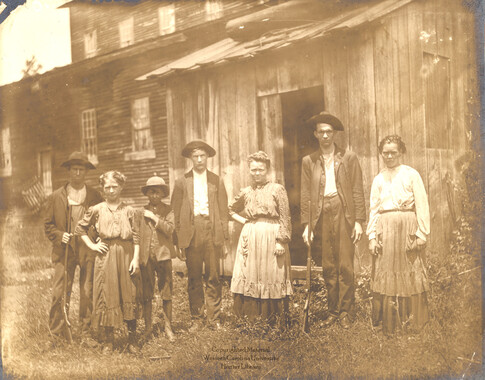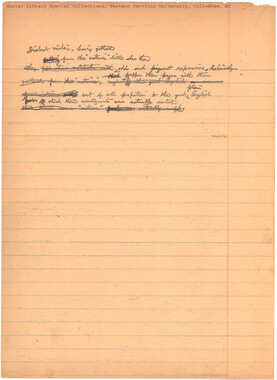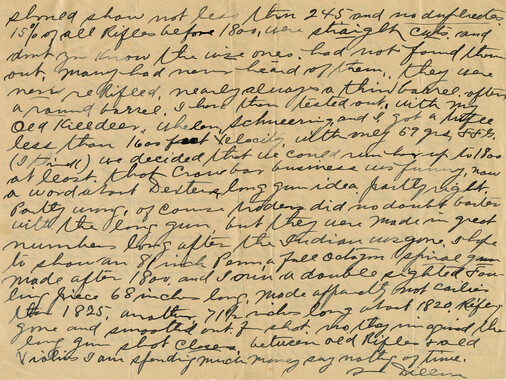Western Carolina University (20)
View all
- Canton Champion Fibre Company (2308)
- Cherokee Traditions (293)
- Civil War in Southern Appalachia (165)
- Craft Revival (1942)
- Great Smoky Mountains - A Park for America (2767)
- Highlights from Western Carolina University (430)
- Horace Kephart (941)
- Journeys Through Jackson (154)
- LGBTQIA+ Archive of Jackson County (19)
- Oral Histories of Western North Carolina (314)
- Picturing Appalachia (6679)
- Stories of Mountain Folk (413)
- Travel Western North Carolina (160)
- Western Carolina University Fine Art Museum Vitreograph Collection (129)
- Western Carolina University Herbarium (92)
- Western Carolina University: Making Memories (708)
- Western Carolina University Publications (2283)
- Western Carolina University Restricted Electronic Theses and Dissertations (146)
- Western North Carolina Regional Maps (71)
- World War II in Southern Appalachia (131)
University of North Carolina Asheville (6)
View all
- Kephart, Calvin, 1883-1969 (15)
- Kephart, Horace, 1862-1931 (290)
- Kephart, Laura, 1862-1954 (39)
- Masa, George, 1881-1933 (1)
- Thompson, James Edward, 1880-1976 (1)
- Weaver, Zebulon, 1872-1948 (3)
- Allanstand Cottage Industries (0)
- Appalachian National Park Association (0)
- Bennett, Kelly, 1890-1974 (0)
- Berry, Walter (0)
- Brasstown Carvers (0)
- Cain, Doreyl Ammons (0)
- Carver, George Washington, 1864?-1943 (0)
- Cathey, Joseph, 1803-1874 (0)
- Champion Fibre Company (0)
- Champion Paper and Fibre Company (0)
- Cherokee Indian Fair Association (0)
- Cherokee Language Program (0)
- Crittenden, Lorraine (0)
- Crowe, Amanda (0)
- Edmonston, Thomas Benton, 1842-1907 (0)
- Ensley, A. L. (Abraham Lincoln), 1865-1948 (0)
- Fromer, Irving Rhodes, 1913-1994 (0)
- George Butz (BFS 1907) (0)
- Goodrich, Frances Louisa (0)
- Grant, George Alexander, 1891-1964 (0)
- Heard, Marian Gladys (0)
- Laney, Gideon Thomas, 1889-1976 (0)
- McElhinney, William Julian, 1896-1953 (0)
- Niggli, Josephina, 1910-1983 (0)
- North Carolina Park Commission (0)
- Osborne, Kezia Stradley (0)
- Owens, Samuel Robert, 1918-1995 (0)
- Penland Weavers and Potters (0)
- Rhodes, Judy (0)
- Roberts, Vivienne (0)
- Roth, Albert, 1890-1974 (0)
- Schenck, Carl Alwin, 1868-1955 (0)
- Sherrill's Photography Studio (0)
- Smith, Edward Clark (0)
- Southern Highland Handicraft Guild (0)
- Southern Highlanders, Inc. (0)
- Stalcup, Jesse Bryson (0)
- Stearns, I. K. (0)
- United States. Indian Arts and Crafts Board (0)
- USFS (0)
- Vance, Zebulon Baird, 1830-1894 (0)
- Western Carolina College (0)
- Western Carolina Teachers College (0)
- Western Carolina University (0)
- Western Carolina University. Mountain Heritage Center (0)
- Whitman, Walt, 1819-1892 (0)
- Wilburn, Hiram Coleman, 1880-1967 (0)
- Williams, Isadora (0)
- 1880s (10)
- 1890s (29)
- 1900s (8)
- 1910s (138)
- 1920s (219)
- 1930s (33)
- 1940s (35)
- 1950s (15)
- 1600s (0)
- 1700s (0)
- 1800s (0)
- 1810s (0)
- 1820s (0)
- 1830s (0)
- 1840s (0)
- 1850s (0)
- 1860s (0)
- 1870s (0)
- 1960s (0)
- 1970s (0)
- 1980s (0)
- 1990s (0)
- 2000s (0)
- 2010s (0)
- 2020s (0)
- Appalachian Region, Southern (43)
- Blount County (Tenn.) (1)
- Buncombe County (N.C.) (5)
- Henderson County (N.C.) (1)
- Jackson County (N.C.) (6)
- Knox County (Tenn.) (2)
- Knoxville (Tenn.) (1)
- Macon County (N.C.) (1)
- Mitchell County (N.C.) (2)
- Qualla Boundary (1)
- Swain County (N.C.) (88)
- Asheville (N.C.) (0)
- Avery County (N.C.) (0)
- Cherokee County (N.C.) (0)
- Clay County (N.C.) (0)
- Graham County (N.C.) (0)
- Great Smoky Mountains National Park (N.C. and Tenn.) (0)
- Haywood County (N.C.) (0)
- Lake Santeetlah (N.C.) (0)
- Madison County (N.C.) (0)
- McDowell County (N.C.) (0)
- Polk County (N.C.) (0)
- Rutherford County (N.C.) (0)
- Transylvania County (N.C.) (0)
- Watauga County (N.C.) (0)
- Waynesville (N.C.) (0)
- Yancey County (N.C.) (0)
- Artifacts (object Genre) (85)
- Clippings (information Artifacts) (15)
- Envelopes (37)
- Glass Plate Negatives (5)
- Letters (correspondence) (366)
- Manuscripts (documents) (273)
- Maps (documents) (3)
- Memorandums (1)
- Photographs (195)
- Portraits (1)
- Postcards (5)
- Publications (documents) (6)
- Aerial Photographs (0)
- Aerial Views (0)
- Albums (books) (0)
- Articles (0)
- Biography (general Genre) (0)
- Cards (information Artifacts) (0)
- Crafts (art Genres) (0)
- Depictions (visual Works) (0)
- Design Drawings (0)
- Drawings (visual Works) (0)
- Facsimiles (reproductions) (0)
- Fiction (general Genre) (0)
- Financial Records (0)
- Fliers (printed Matter) (0)
- Guidebooks (0)
- Internegatives (0)
- Interviews (0)
- Land Surveys (0)
- Minutes (administrative Records) (0)
- Negatives (photographs) (0)
- Newsletters (0)
- Newspapers (0)
- Occupation Currency (0)
- Paintings (visual Works) (0)
- Pen And Ink Drawings (0)
- Periodicals (0)
- Personal Narratives (0)
- Plans (maps) (0)
- Poetry (0)
- Programs (documents) (0)
- Questionnaires (0)
- Scrapbooks (0)
- Sheet Music (0)
- Slides (photographs) (0)
- Sound Recordings (0)
- Specimens (0)
- Speeches (documents) (0)
- Text Messages (0)
- Tintypes (photographs) (0)
- Transcripts (0)
- Video Recordings (physical Artifacts) (0)
- Vitreographs (0)
- Horace Kephart Collection (729)
- A.L. Ensley Collection (0)
- Appalachian Industrial School Records (0)
- Appalachian National Park Association Records (0)
- Axley-Meroney Collection (0)
- Bayard Wootten Photograph Collection (0)
- Bethel Rural Community Organization Collection (0)
- Blumer Collection (0)
- C.W. Slagle Collection (0)
- Canton Area Historical Museum (0)
- Carlos C. Campbell Collection (0)
- Cataloochee History Project (0)
- Cherokee Studies Collection (0)
- Daisy Dame Photograph Album (0)
- Daniel Boone VI Collection (0)
- Doris Ulmann Photograph Collection (0)
- Elizabeth H. Lasley Collection (0)
- Elizabeth Woolworth Szold Fleharty Collection (0)
- Frank Fry Collection (0)
- George Masa Collection (0)
- Gideon Laney Collection (0)
- Hazel Scarborough Collection (0)
- Hiram C. Wilburn Papers (0)
- Historic Photographs Collection (0)
- Humbard Collection (0)
- Hunter and Weaver Families Collection (0)
- I. D. Blumenthal Collection (0)
- Isadora Williams Collection (0)
- Jesse Bryson Stalcup Collection (0)
- Jim Thompson Collection (0)
- John B. Battle Collection (0)
- John C. Campbell Folk School Records (0)
- John Parris Collection (0)
- Judaculla Rock project (0)
- Kelly Bennett Collection (0)
- Love Family Papers (0)
- Major Wiley Parris Civil War Letters (0)
- Map Collection (0)
- McFee-Misemer Civil War Letters (0)
- Mountain Heritage Center Collection (0)
- Norburn - Robertson - Thomson Families Collection (0)
- Pauline Hood Collection (0)
- Pre-Guild Collection (0)
- Qualla Arts and Crafts Mutual Collection (0)
- R.A. Romanes Collection (0)
- Rosser H. Taylor Collection (0)
- Samuel Robert Owens Collection (0)
- Sara Madison Collection (0)
- Sherrill Studio Photo Collection (0)
- Smoky Mountains Hiking Club Collection (0)
- Stories of Mountain Folk - Radio Programs (0)
- The Reporter, Western Carolina University (0)
- Venoy and Elizabeth Reed Collection (0)
- WCU Gender and Sexuality Oral History Project (0)
- WCU Mountain Heritage Center Oral Histories (0)
- WCU Oral History Collection - Mountain People, Mountain Lives (0)
- WCU Students Newspapers Collection (0)
- Western North Carolina Tomorrow Black Oral History Project (0)
- William Williams Stringfield Collection (0)
- Zebulon Weaver Collection (0)
- Appalachian Trail (6)
- Forest conservation (2)
- Forests and forestry (5)
- Great Smoky Mountains National Park (N.C. and Tenn.) (18)
- Hunting (7)
- Maps (2)
- Mines and mineral resources (3)
- Postcards (1)
- World War, 1939-1945 (4)
- African Americans (0)
- Artisans (0)
- Cherokee art (0)
- Cherokee artists -- North Carolina (0)
- Cherokee language (0)
- Cherokee pottery (0)
- Cherokee women (0)
- Church buildings (0)
- Civilian Conservation Corps (U.S.) (0)
- College student newspapers and periodicals (0)
- Dams (0)
- Dance (0)
- Education (0)
- Floods (0)
- Folk music (0)
- Forced removal, 1813-1903 (0)
- Gender nonconformity (0)
- Landscape photography (0)
- Logging (0)
- North Carolina -- Maps (0)
- Paper industry (0)
- Pottery (0)
- Railroad trains (0)
- Rural electrification -- North Carolina, Western (0)
- School integration -- Southern States (0)
- Segregation -- North Carolina, Western (0)
- Slavery (0)
- Sports (0)
- Storytelling (0)
- Waterfalls -- Great Smoky Mountains (N.C. and Tenn.) (0)
- Weaving -- Appalachian Region, Southern (0)
- Wood-carving -- Appalachian Region, Southern (0)
- StillImage (296)
- Text (647)
- MovingImage (0)
- Sound (0)
Horace Kephart Journal 26
-
Horace Kephart (1862-1931) was a noted naturalist, woodsman, journalist, and author. In 1904, he left St. Louis and permanently moved to western North Carolina. Living and working in a cabin on Hazel Creek in Swain County, Kephart began to document life in the Great Smoky Mountains. He created 27 journals in which he made copious notes on a variety of topics. Journal 26 (previously known as Journal XVII) includes information on firearms. Click the link in the Related Materials field to view a table of contents for this journal.
-
-
1 • FIREArulS. 1 .. WHAT SHOOTING DOES FOR THE SHOOTER. All forms of sport have an effect on those \ ho play them and the effect on the player is often n dcterminin factor in the value of the sport. In many way:; shooting with a shotgun, rifle or pistol either at a target or hunting in the lield is an especially \'alttahle sport. It gives recreation and in addition develops to a high degree the mental faculty of concentration, and in fact a shooter's success depends to a very large extent upon his ability to concentrate and co-ordinate the effort of every nerve and muscle 1to get the desired result. Slip- hod and careless people never become e~pcrts either os hunters or target shooters for they will not devote the necessary energy and thought to their problems. Consequently the man who makes a ucces of shooting is necessarily the one who can keep his mind working along the proper c-hannels. Boys and young men a.re often lacking alonrr th,•s" lines and that is o11e of thr reasons why shooting should he ,·nconragccl especially in school and eo! leges. \nother feature of shooting, and one which is rather important is th training of the ~hooter' , t'ye. m. n wf10 ha. done a great deal of hooting, especially hunting, develop keen powers of obs rvation and u ually set'. things m re quickly and accurately than the average man who has never used his eye citht•r to locate wary game or to make close visual adju t ments such as are nece. ary in propt• rly lining up the ights of a firearm . S OOTERS ORGANIZE TO REDUCE PRICES Pinehurst Trap Contestants Protest Against High Cost of Shells and Tar,ets. MAY BUY FROM GOVERNMENT , I Army Ammunition $aid to Bo Avail· able - May Bring Restraint of Trade Charge Against Makera. /iprmal to The Nt:VJ l" ork 7'''"""" PlNt•:HlJHST, N. C., Jan. 23.-l<'ollow, nt; tlJP unusually auccesldul mid-winter h·ap shooting tournament at Plnehur11t. t which shooters !rom a.ll parts ot the eonnlr) were present, a. mau mootln~e presiu d over by John Phillip Sou~a. lh1• famou11 band ma11t~r. w a held today to prot st 11galnst what tho~e pre,._ nt tf'lt to b• tlH• ·ccsslv('ly high 1·ost of ammunition, ta.rgeta and oth r tra.p ootmg te<·csaorl<' . . Ford eeloy of Bal mor , ll1d., was lected p rman nt retar. ot the or· cunlzatlon nru! ,-a.~ authorlzod to take MUch ~ll1p ~~ ho aaw tit to obtn.in IL ~oundor tlnanc·tal bR.SI& tor· partlclpaon In the •port, His in,.tructfona were followa: To 1\'et In touch with gun club" and hoott~ra ot the Unlt<>d Stn.toA with a. view to oo-op ration In the l'ffort to re• duco the costa or tarsets atncl mmunltlon. 'l'o take 11 hi~ tlr t tE<p In tha rAIIuctton of co•t the purchas<> 1'rom thA Oov rnment or Ill! 'P.ral million dollars' orth or sh lis 1111d ta.rgct which wer" bought for war purl)Q P.! and r no\11 reau~ for r h•u an. l\ ant ( o·Oper tl.-e Buyln~r, To obt In from the l!llll clubs ani! to punl "" throug1t seer tary all sh 11 and ta.TJ"ets wlu h th y use tor a p rloQ. ot five or ten y ars. H Mcoaaary t build a shell and tar&'et factor'l', for the baeklng or which those pre11ent pledg d thelt· t<Upport. 'T'o sof'k legal advlc" to detonnlne ·hetb"r the munition <'Ompanle.!l were not ar.t!Dg In 1 • tr tnt ot trarl In their anheren~ to an all~ged agreement to keep prices nt th ir present lev 1 for anothn~· year • '. • wman or Indiana r port~ that the 11111 club of. which ho II! a membor hn.d purchas d shells from tho GoYernment a.t 23 a rase ot one t bous11.nd, ond had found them to be ex trem I~· Ratlat ·tory. This frgut<> Is llfl&rly one-halt the present market price. Prole t rrlce of l'lbeUo. Se ral or those pr~cnt apoke of the present high cost, pointing out that the prl<'e9 or almost all other commoditlef, including paper, braBs. copper and lead, had dropped, while the price of shell~ r ma.incd at the maximum fl&'llre which they had attained durlnK the war. Trap ahootcr11 from thirty-two , tates of the union, tn~ludln~ practl<'ally all the SLates east or tho Mltu•IMippi and many ot tho ·we~~tern ones, took part In the meeting. 5. MARKSMANSHIP. .- 8. M. as 10. 1:3. ~~~ a..J.~~ 06/6i 17,/.LJ. r~. ~ 1~·- 0/l.,~-.t . '..1o,.2Q. M. for Self Defence. M. as National Insurance. - ~~ _:38; f~1 11A ~ll.,,IJ<Ir "'''r, 3~1 . .JWc-/..ll/tf6 (~-/1'#,./j. 0 ~:;:. 1 "P• )3, 1-. 5 U.S. HAS 7,000,000 HUNTERS Returns From State Lleenaee Amount to $4,500,000. \ 'Thrr" !Iff' 7,()1)(),000 hunters In the t tlll"ll StatP~. &<'cording to the Chief . 1:amc \ tu·llt>n In thP. Hlo1ogl..,al Survey lor the l nil •<l i'tntrs Urpartment of ,\ln·lculturf'. '1 his estlmnte waa made r, om , cports issued by the \ arloua I Sllilt'S. In 1!11!1, ::,oov.ono State th·,.nsf!a ""'" l su••d, nntl In a<l<litlon It Is rstlmated thn t :l.~>Otl,OOO hunlt•rs nrc E" em pled un• tJ(•t· , nrloiiR 1-'talP. provleton~. The re• \llnl" to th<' Ktnl<'R from lkensNI wall APPro. tmatrh· $a,r.oo.oon, ~til of which wtt~ PXpNtd••d b) th~ Stll.tPs In ndmlnll• trntlnn ,,f St><t•• IRWR In th (\rotectlon or gntnP.. 'Thl~ \ttn p<'rmlt• the emploY• mrflt or appro lnuttch !!,0110 fl&.larled f:,•trttfl t:atn•· \'uniNlS »nd r.oo (flit! war• cit n~. Th<' t'ongrrMional approt~rlatlon tnr Ft•rleral gamn "0\tH<Irn Hf'nl<'<' for prnl<'dlon of mlgrnt<W) bh d~ II! '142,1\00, "hll'h twrmlts the ~mplo,.mr.nl of onl:r t 'f'nt ~ -nln•• "R rd<'nf'. \ t it~ •·•·cent "'~~tlng In 011""'8, the Tntt't'nnllonal \Asor!Rtlon of Fl~h. Game anrl 1 'on ~n Ill ion l'omml~~lonrre lldoptl!d n n·~olutlon ,.n lUng fnr th" I@BIUlnN• of F<'<l••rnl lit"e!'l"""' for hunting migratory birds Th,. •·cl'omnv·ndatlon "aiiP.d for !lt·~n•c~ In the fonn of flpPdal 11lampa 1" h" I~I'H"<l b)' po~t mallt"rs and At· lt•~hPtl to 1-\tat!'l llcrn~l' . lt was e .. u. mntf'<l that the rev<'niiA from 11ur.b lit on""" -..·oulrl .amount to between $1,000,()()() and $2,000.000, ..-hkh could be us <I for the proteetlon of g&.mfl, o, Trap Shots are Made- Not Born By H. H: STEVE~ S Mr. Stevens i now and was last year the manager of the trapshooting school in Atlantic City, N. J. lie is a student of trapshooting and on idered one of the most efficient instructors in the United States. Therefore his views on this subject are worth while. JUST as long as the earth revolves there will be people insisting that expert marksmen are born-not made. My experiences as manager of the Trapshooting School on the Million Dollar Pier, Atlantic City, N. ]., cause me to take the opposite view-that marksmen are made not born. I had a great opportunity to study people last year at the trapshooting school and I got a lot of quiet amusement out of watching people who had never fired a gun, take to the sport like a duck to water. There was more fun still in coaching experienced shooters out of the "SO-SO" class. Of course, in the case of a raw beginner there may be need for but very little instruction, or he may require a great deal; but at the worst it is simple, because he has formed no habits. llaving by a few simple t~sts determined the eyesight presents no dtfficulty, and selected a gun with a stork o £ a shape to fit reasonably well, then a little instruction in handling the gun usually starts him breaking targets. The rest is a matter of. refinement in gun fitting, coaching and practtce. Naturally, some beginners make progress faster than others. But it is not that one is endowed by nature with betler shooting ability than the other, but that he simply learns quicker and better. The most common of all faults and which most handicaps almost every beginner and every dub shooter, is a bad shooting position. This can be corrected, in most cases, very easily by coaching. Possession of a gun which does not fit the shooter cannot be correctly called a fault; rather, it is a misfortune. The beginner. in wing-shooting knows nothing about selectmg a gun to fit him. And I usually find that the man who comes along and confesses to me that he had some experience but is a poor shot has been handicapping himself with a misfit gun. Generally he doesn't even know the dimensions of his gunstock. Reverting to the subject of position, the beginner and very often the dub shooter, when taking up a gun for the first time. at the sc??ol, would assume a decidedly stramed pos1hon, holding the gun awkwardly and balancing at the waist with hips thrust forward and shoul< lers back. :t-laturally, each had to he taught to stand firmlv on both feet, lean slightly forward and swii1g freely from the hips. For another thing, sometimes the beginner showed an apparently unbreakable destre to raise the check from the gun stork when the target appeared in Hight, and, of course, continued to miss until he learned better. Other grave faults were inclination to hold too long on the target before ftring, and flinching. \'ithout coaching the tyro \yon!~! not easily outgrow these faults, but wtth tt rapid progress was always made. I have fonnd it interesting and useful to study the beginners from the human-nature standpoint. For instance, supposing a new man comes along: it may be a good thing to just let him find his way around, so to speak, and not give him too much attention. TT e gets a gun. and you sec at once if )1e is familiar with it. J f not, you will see hun watching the other shooters. This he will do either frankly and with manifest iutercst, or out of the corner of his eye. If the former. you know you can go right ahead and trll him and he will learn quickly; if the latter, you' must take your time, only suggest things, ask diplomatic questions and let him have the pleasure of finding it all out for himself. By using a t rygun, the construction and use of which has been descrilwd in previous arti des. we take the exact Itt of each shoott•r, thus insuring a proper gun is provided for use during instruction and also enabling him or her to ohtain r rom any gun maker precisely the fit in a gunstock that it is necessary to have to shoot well. l1ut among all of the many heginners I haven't found a single born crack shot nor one who cnuld not learn . 'I he prevalent, arly idea that pi tol hot~ wer born and not mad per-hap. had it. rio·in in r markabl tri~k- and !'nap- hooting, a. typifi d by th' work of cv ral mark. m n who either pr c d d or w re cont 'mporary "ith the Benn tt. and Paine. A w rd concerning . ome of th se . nap-shots and th feat. ·r dit d to th •m is not ami. , although th v ry natur of their sho ting pr eluded any record of th ir work on a . tandardized basis. Perhap .·hibi-tion shot wa , \Vh "as well known t th . hooting fraternity in 1R57 wh n, it is ·aid he sent a pi ·tol ball through the hat of l\1. Blondin whil that l •brated worthy was cr ssing iagara Fall on a tight rope. At the time, it i. said, Travi. wa 36o fe t away from Blondin and tired from the d 'Ck of th • laid of th :\list. Many other cemingly im-possibl f ats wer credit d to Travis' ~kill. Travis, in addition to h ing a celebrated shot, condu ted ho ting galleries through the \Vest and South. "T. ft Hanel •d harlc)" Damon, th ~lichigan E.·pert, was touring with Hroncho Tohn's shows about the time the pistoi'shooting gam l)(•gan to tak • stan<larrlized form. lie wa. a man of con iclcrahl • cclu ation, an<l uncanny sl ill with the pistol. IT e i said to ha' e h •en able to shoot in mor' than so differ nt positions, hitting coins ilipp ·d into the air, shooting whil' jug-gling with pistols, and p donning oth ·r unusual feats. He was one of the first men to use a .22 calibre Colt!' swung in a . ..g calibre frame. Dr. J. \V. Hamilton, of J cff rson, Texas, wa renowned a a pi tol shot, as well as an expert with the rifle, and aft r enjoying a local reputation for ;:. lon~ time, he undertook a tour of the Umted States in the late Eighties. o particular record were kept of his skill. but accounts of hi hooting from authentic source~, publi hed at the time, credited him \ ith having broken 24 out of 25 brickbats thrown into the air during an exhibition he gave at Vern on, Texas, in .\ugust, 18 .f, with a ·3 calibre revolver, and with having broken 4 out of 5 gla s balls, al o thrown into the air, at J effer on, Texas, on February 4, I 5· I . Long Range Revolver Shooting RE the subject of revolver shoot- Riverside. I have seen him hit a ing as discussed in the article jack rabbit three times in five shots, by Van Allen Lyman (September the jack running through sage brush OuTING), I have seen a friend ofmine, three feet high and my friend on the whom I have known all my life, shoot back of a galloping horse thirty yards with a .32-20 Smith & Wesson, six to the left. inch barrel, on many occasions and In this case one ball went through this is what I have seen him do. both ears just above the skull, one I have seen him pick up the gun and drilled the left ham, and the third shoot from the hip at four blocks, went through the lungs. 4 x 5 inches, set in a row at fifteen I have seen him kill a flying raven feet distance, and hit each one at at thirty-five yards and at once whirl four consecutive shots. I have seen and kill a ground squirrel at the same him whip the gun from the holster, distance with his next shot. This at as a mountain gray squirrel ran Catalina Island. across the trail twenty yards from us, I have seen him shoot a match fire from the hip and knock the bark against seven competitors at the from a log the squirrel had jumped on, militia rifle range, the others shooting less than an inch from its hind feet and fifty yards and he seventy-five, with kill it in the air with the second shot the result that he won by three points. as it jumped from the log. He says that hip shooting is good at I have seen him kill a jack rabbit at short range when you have to hurry, 93 yards with the third shot, as it but he prefers to aim. Yet he can hit hopped along an orange orchard at pretty well from the hi p. E. E. H. 0 .... .Jj<;e. 116 • 14.- FREAK SHOTS . (See article " Some Gun ! ") Some Gun! SOME men ju>t naturally cannot keep from hitting game. They are born ~ho t5. Maybe it ih the gun used, im;tead of the man, but at any rate we have all met the fellow who kills game with uncanny regularity. nder ordinary circum' tances, seeing is believing, but when it come5 to fishing and ~ hooting yarns, we long ago adopted the rule to believe nothing that we heard and only half that we 5aw. The illustration on this page shows you what we have 5een and we are going to tell you the tale as told to us. You can give the credit to either gun or gunner, as you see fit. On December 15, 1918, George S. Scofield, a lawyer with offices at Room 2289 Woolworth Building, New York City, and Capt. George Ackerly, a professional guide of Patchogue, Long Island, were shooting ducks from a double battery on Great South Bay. In this form of shooting the gunners lie side by side in the coffin-like compartment of the battery which is anchored off shore. As the duck5 come into the decoys which surround the battery, the gunners sit up and open t1re. A flock of broadbills decoyed. Both gunners rai,rd and fired one barrel. For the second shot Mr. Scofield was following a bird fairly well up in the air, while Captain Ackerly had picked out a bird closer to the water. Just a5 1\[r. Scofield was about to pull the trigger, his bird crumpled and fell and he felt a jar as though his gun had been disrharged. However, he knew he had not shot and on opening his gun, he found the ·shell had not been fired. 1\Ir. Scofield explains the incident in this way, and he has the gun to prove it. Just as he was about to fire, Captain Ackerly, swinging ahead of his bird, pulled the trigger. The charge from the Captain's gun hit the barrels of Mr. Scofield's gun about SL"< inches from the muzzle, entered the left tube and followed on out the barrel, killing the duck that Mr. Scofield was aiming at. This barrel was almo5t entirely clo>ed and had Mr. Scofield pulled the trigger, the gun would undoubtedly have blown up and possibly killed both gunners. There you have ill Some men just naturally cannot help killing ducks, or maybe they train their !(Uns so no effort on their part is necessary. 13~ rl.~!J-~~":" ~ oli,'~ ':J.~, 16fl • 15. OK 1 ~·'18,:"17 18. Casualties in the Hunting Field. ttY. I-t5 23. Choio o 1 ~,Ill-b. • 25. RIFLE BALLISTICS. 28. Exterior Ballistics. r;;lt&. 1f -r- ~ ~,-.lJZ>N'7-J67, r ~ 1-~ ~. 1/))/o.f'- 17"· T~ t ~, FlJ/71-179'. 25 0. Drop of Projectile. Gr vity. !14vl.l f· 32. Air Resistance. ,t(); ''''· J lC' :1 r.J&.. "} J>Ld;ar;; .. , 1 ...w. 1J';l>)J-s. tr--··£.,.. /frY" .. .. .. 71JJ-9.1(. " ..IIi/(;'~ 1- +-,i--~. "P':iJft/1, 35. Form of Bullets. 1luvt-; //(), 30 38. Ballistic Coefficient. Camp· r tive Efficiency. 38 40. Y~ 1-e ~ ~ ~- . p;IJ~:~.. ,. .• ,, '• ~ ~l.f..Jibgz 4M-.At '----'=-~ ,. .. ., " • 1-~· JT,Pt/6. _ T~· I • ~ ~ J • 10 tMJ;-:e 1-r-MY:"~- 1 ~.,.~- ...... , ... ~~ , .. , .. u 4t ... /111/, ~,J .,&..., q-~MV. ~· ..- ....,..~ <$- .IY.:J: 1i'ZJ 39. ;u:l> :~f. F$1J-'/D. /f]J-t;. an.+ovo-~ ~ ? ~~- -;u,]J$1, 47- T~ 4-~---.. m.s:s; % c ~-;;..J;- ,.. r--;~-. -;JZl.f'7. ~ . . ......... ~. lfli -1''/- Sectional Density. J(.u..l.-: /d6 - 107 - 42. Torpedo-shaped Bullets. "£,.,.1:" J o:.J'. • 'J. "13 i"J14¥- 117, Jl7l J-..'2/, ¥1. ;...;;-.. ..-.-;;· ,a..;-. 45. Tubular Bull ets. ~o: (SJ)("'Onl to The Citize n. ) DAYTONA, Fla., Feb. 18.-Travel• inc taster t h11.n a nythinc on whee\11 hu 'ever traveled before, Ral ph De Palma ,drtvln• a spe cial P llokRrd, ' equipped with nn air plane enatne, ' ye~terdny brokfl the record fer the ktlometre {five-eighths ot a mile) a.nd the mlle. H ie r a te ot epet~d wn11 149. 7ll m11M p er :hour u c ompared with the previous r ecord of Bob B urmnn ot 141.72 mlles per h our, made I eig-ht yenrs ngo with a Rlltzen Hen:r. DePalrna.'fl reeorrl for the 1nlle, otflcln. llJ' tlmccl by the A. A. ,A. rmrl a'nnounceo by Richard Kenn~r Dell, of thEI A. A. A. contest boRrd, If! U.Oll ~ccondA as c-.ompared to the Burman record ot 25.41 seconde. D Palma I nnd his Packard lowered the kllomPtrt~ record from 15.88 to 15.86 ~econllB. D!'Palma's Pl\ckard le a 1nuc'1 emaller c11.r ·than the huge Germo n I Blltzen Benz driven by Burman, but the new aYlatlon engine glvet~ It a. slightly grenter horse-power, the l'ackllrd showing about :!60 horHEI· powet· as compared to 250 tor the Hun car. . The driver believed that tr lvho•t~ls nnd tlrNI can be built to stand lht~ atra!n, It Is going to be pt)ll!llblc with his Pnckoro, designee! to overr.ome I "vacuum <ln1g," to make cloee to 300 mllPil pl'r hour. It ie hie n mbition to make faster time with the !'n.ckard than has eYer bPen made on lano. 11.1r m· water. and he slatec'l today, followIng hill cff<>rt of ~·estcrdf\y, lhnt he would not only be able to lowtor hI~ own record In the n~>ar tuture, but woul<l lowPr the record of everyth:·~; xccpt a bullet. ·-....,.,.---,. 48. Photogr hing Bullets in Flight. 50. Velocity. 7!1Jt;l. (!,.,__ if~ _;.,._~v, 7QJI.<-. }1t..:it.lll': ..'J:d .u.l7; ~ ,.~~"'~~~. "7fi)67. 7f.t-C;/I/: " .. .. " .. " " ~· -;rt--1../JRdr. 117>61': ~ .. " .. .. •. .• .. ~~· 7!17>6'/. .... - .. II ,. ~· h •• 4. J t(; ' ( I 7/iA >•· ~Mv .. e. J;s P~~ ~. 7I:tJ:<r. ~ ft1 v .... .n-. v. "r ~ "~-17t./-; 73JJ :J.1. ~ ~~ ~. ~-~ ~ ~ -R. 70>6"/t, 52. Velocity and Barrel Length . ..d.u~ us; 7l~~ 71".1> 7"· 55. Chronographs. f77>6.2,~-6s: 48 "'c quot.: below from an English contemporar) n table givinl! the re.ults of an interesting ~cries of experiments to determine in a general way how the munle velocity of a rifle is affected b) the length of barrel, the cartrid<Yc in each case being the same. It will b; noted that the falling off in velocity is 51 feet per second for five inches' loss in length in the first case, while the second cut of five inches decrease> the muzzle velocity h) a further 68 feet per ~econd. This raise~ a question as to the c'.act length of barrel whi h is absolutely essential for reasons of velocity. In some later tests, when the same barrel was reduced a further five inches in length, a loss of _Q per cent in energy was recorded, which is probably explained by the fact that the burning gases give up the whole of their force quite early in the passage of the bullet through the barrel, so that the greater part of the impulse is gained by about the midpoint of the barrel; while for the last five inches in the case of the full length barrel the enr1gy imparted to the bullet does not greatly exceed the friction of the same again t the bore. _ VELOCITY OF .303 LEE-F.NFTELD WfTII THREE DLFFERENT LENGTHS OF 13AlU~t::L . Cartridges used : Kin ~t' s Nort on 1\fnrk Vfl. tubular cordite ancl 175 grains 11oint cd hull e t. V e lot' ity mcosurcd over 50 yards. narrrll Length. ~0 . 1 9 in. 1. 2fHi t f. s. 2. 25!i4 u 3. 2fifi() " 4. 252[, ,, 5. 251 i 01 6 . 2£Hl i " 7, 2;)1~ H H. 2fl40 " n. 2 fi 16 " 10. 2512 " Length, 25.1 n in. II. 21H8 f. •. 12. 2520 .. ] :1, 2504 H II . 2[)01 H lfi. 2501 .. HI. 2 1R:l " 17. 2 1RH " 1 H. 2471 II ]9. 2•170 " 20. 24 H3 " Av. 2514 " Av. 2403 " Muzzle velocity 2601 .. 25 50 " Mt:nlc 2627 ft. lb. 2523 fl. lb. Length , 20. 19 "' · 2 1. 2 lOH f. s. 22. 2 121 .. 2:t 2 1:{3 .. 2 I. 2 113 ., ~ ..}. . 2 170 .• 20. 2 ~ G-1 '' 27. 2417 .. 2H. 23116 " •>n t) t•>o " 3iJ: 24J7 .• 1\ v. 2426 " 2482 .. 2302 ft. lb. 58. TRAJECTORY. "J'luvk I dO-I 11(. rp-~t;:;.j~ ~. ~3~ -$W-- ~ 1-P?U-~-~~·41J.t-? ~;:.y·. jlll)Jo. ~ ~LL; J.,- ~Iii-. 7i'~3o. ~ k:i....-, e ,.,.._,{ ltll'j ..t' .u{-:____:.t-~ . /flJ J o, /'iT ,1.,).-; ~- ~-; 1-- ~lc. 1.~-1- ~: 7.171-T/, ~ .lrC; -,&. ~ 4~· 1J/:)1Jl/. M/rt.. tp- ,3o4.-.:.:,l ]7)>Jfl.).. /turl":/h-f.lll, 60. Seeing Bullets in Flight. 58 62. Range. 65. To Determine Range. 68. Extreme Range. ~+~· 7JJ) 7?. ~· 11)>15 7 -167- ?0. Vertical Firing. 737J77,7,y. 20:ct. ~, w 1 JffZ• 1 : _,,,, 62 Vertical Firing Editor Outdoor Life.-After reading Mr. Thomas' article on "Star Hunting" In the September issue it occurred to me that perhaps the results of some experiments on this line and the computations on altitude, time of flight, etc., might be of Interest. In the first place he has evidently been misinformed as to the range of the Springfield rifle, as he gives it as between seven and eight surface miles. Springfield, but can submit some on this work with the English service arm. The English Mark VII bullet weighs 174 grains and the velocity is 2,440 t. s., so there is after all not so very much difference in the ballistics of the two cartridges at long range. Mr. Tippins and other well-known English rinemen have succeeded in timing the flight of vertically fired bullets. The Ordnance Department gives the extreme range of the Springfield as 6,4Gfi yards, or a trifle over three miles. In this shooting the firing Is done at an angle or 45 degrees. The highest point of the trajectory is 6,844 feet and this height is reached at a distance of 3,432 yards !rom the firing point. The angle of descent Is about 68 degrees and the bullet strikes the ground with a remaining velocity computed at 203 ft. sees. Time of flight computed at 31 seconds. One or their interesting observations is that it strikes the ground with its point in the same direction as it leaves the gun. If fired straight up it comes down base first. The table or computations on vertical firing with English service ritle is as follows : Height Velocity. Ascended. Time of Ascent. (Feet per second) (Feet) (Seconds) 2,440 0 2,400 59 2,000 680 1,500 1,569 1,000 3,238 500 7,139 0 9,816 0.00 0.02 0.31 0.84 2.22 7.68 19.66 Like many other readers of Outdoor Life, I began my shooting with sllng·shot, crossbow and bow and arrow. From what I could see of the flight of the projectiles I used I always supposed they carried farther when fired at an angle than when shot straight up. So sure did I feel of this that I told a friend that in my opinion the Springfield would only shoot about two miles straight up. The bullet takes 31 seconds to reach the ground in its return and strikes the ground with a velocity of 473 feet per second. I have no data on vertical firing with the To settle a dispute could you please tell me whether a bullet fir d straight up from a Springfield rifle will reach the ground at the same velocity as It left the rifle? Will the bull t fall base or point first and what will be tho energy when It hits the ground? Also, how high will the bullet go?- I-I. N. Anderson, Portland, Ore. Answcr.-The bullet would strilte the ground with a small fraction of the velocity It possessed when It left the muzzle for the reasons given In the reply to Mr. Malone In this Issu e. If you have disturbed Its flight It would strike base first, but they occasionally tip over and fall point first, In which case the velocity at strildng Is decidedly higher than In case where they come down base first. We have no data as to how high this particular bullet would go. The discussion you have In mind will be found In the January, 1915, Issue of Outdoor Life, pages 88 to 90.-Edltor. () -1.4 .. , a-,., I 'f 17. If a rifle were shot vertically and after the bullet came back to earth would the speed per second be the same as when It left the rifle, or less. If a round ball weighing a pound, and an ordinary buckshot, were dropped from an aeroplane a mile In the air, would they reach the earth at the same time? Both of these questions to be practical, takIng Into consideration air resistance, etc.; not as to textbooks on physlcs.-Carl Mahone, Cleveland, Ohio. Answer.-The bullet on striking the earth would have much less velocity than when It started upward for the reason that many times as much of thE!- energy of the bullet Is absorbed in overcoming air resistance as In overcoming the attraction of gravitation. The energy thus lost Is lost forever. On the return trip there Is likewise a great deal of energy absorbed by the resistance of the atmosphere, and this, likewise, Is lost. The energy the bullet possesses when It strikes the earth Is that absorbed on the upward trip in overcoming the attraction of gravitation. Touching the dropping of the ball and the buckshot this would depend altogether on what the ball were made of. If it were lead the larger ball would reach the earth more quickly than the buckshot, as It would overcome the air resistance better. If it were o! lighter material It would depend upon Its specific gravlty.-Edltor. California. E. L. STEJVENSON. Some weeks ago I replied In your valuable magazine to one "Bill" as to bow high a rifle will shoot. I also spoke of a question in mental ·arithmetic as to how a, person could increase his weight while standing on the scales by lifting up as much as possible, or by reaching up and pushing up with all his force on the beam of the scales. .I asked Mr. Chauncy Thomas why it was so that my weight would increase according to the amount of pressure exerted, to which Mr. Thomas replied: "Nonsense," "Impossible." That gentleman knows very little of Euclid, for it certainly increases your weight, according to the amount of pressure you exert over your own weight. Mr. T. has not tried it, hence he does not speak with the knowledge of "proof."- E. M. Herron, Cleveland, 0. Answer.-Mr. Thomas was certainly most disrespectful. A man would show • the same increase in weight under the circumstances mentioned as a spring would thru being placed in tension. Unfortunately very few scales are sufficiently sensitive to measure this.Editor. 72. Influence of At~ospheric Changes. r~ IJ"-p)/,.-~. 1lMo-qll. $' ,/.d;; .JZfur~ 1-~--~rr ~- d.-q~- 10/.23. 75. Barometric Pressure. 11J81- 77. Effect of Altitude. f{JJ~7,1d. 80. Humidity. 1SJ) 9 6. ;+lu£-, 1.?6. 82. Temperature. p-:a '!cJ· ~'!OS: S/tFM, 7f-8o. "" • .2l., S1t : t 85. Winds. ..r- ~ V.1tJY~.t.~ ] iD99. 7f-,t"./8f-ll/. ~. 91 .:1~ 1 ~~· ~10!, /0~. A;,; • .,pu +..~~ut.I3 - J./.6. ~.?9. 72 • • • • • Here is a freak group of unusual interest. Ten shots were fired from a Springfield rifle, at 300 yards by T. K. Lee at the annual qualification shoot of the Jefferson Rifle Club of Birmingham, Ala. The group was three or four inches from center at 10 o'clock. The time taken in shoot:ng was 7 5 seconds. The rifle had been fired 52 times without cleaning when this group was made. The cut is actual size, 3 inches by 5 inches. (. }T!. ( 8?. -"J{l-JI/3 _-ps·; J)ri_ft. • 8? ~tPU~n--t:"-113 , ACCURACY. 4.4 1#2.$a•MOI •. lwr../f..1- __,,.~· ..... __, ,t /S'"Y. ~ "'7· ~.!- , 7-> 90. Mean Vertical, Horizontal nd Absolute Accuracy. 7JJJ /1"1- /.2P. 91. 92. ~/17· Effect of Deformed Base or Point of Bullet. nu;;c;; oo. ~1 1/:J . A~ ·-Jw~~ ~ ~f~ .%0: 6fJ, ~~~~-~i'T< 95. Effect of Grease in Barrel or on Bullet. (~~ - .~1ry~ .. /3Jr ~'1~~-~-/07- (( ., ..fi.IJU"'•~ft'~ '17. ~ 1-~ w....--. 98. Effect of Shooting from Rest. k 49 .YJ't, ~~~ 77. a{u[.,..,17fJ., SAF~B::2 Z.O~If. ~ 1 1 1 l'lt·ns•• l<'t m•· know your opinion of th•• aec•ur:H.'>" an<! reliability ot a takedown rltle action ns compared with the onc-piN·e rifle.- 1. ,V, Blachly, L mmon, S. D. Answer.-In answ ring your question we cnn glvt> only our p rsonal Impressions. When nny rltle Is !Ired It is thrown Into a state of vibration thru Its entire length, th vibrations beginning with the jar of th hammer !nlllng, beIng Increased by th explosion of the primer and still mor so by the ignition ot the charge, and this regardless of the type of weapon fired. Obviously ljeavy barr~?ls vibrate less than light, and heavy guns less than light. The vlbt'a· tlon originates In the barr 1 and Is transmitted thruout the gun. The best shooting Is obtained when the entire iJfle vibrates as unltormly ns posstble. For this reason the more tightly the barrel Is screwed Into the action the more uniformly will the entire rille vibrate, but there Is always Interruption In the vlbrat~on at th'ls point. The utility or the one-piece stoclt rs In that It passes this point ana tends to distribute the vibration uniformly over the entire gun, hence a rifle with a one-piece stoclt shoots more accurately than ~ rltl.,; with n two-plec stock. While on with a two-plec and the barrel screvt,ed tight ly Into the action shoots more accurately than one with n two-piece stoclt, the barrel of which Is loose In th action. The joint wh re the barrel joins the receiver Is the point wher·c the mischief Is <lon . vVo nrc nwnro that this may cause many of our renders to !mmedlnt<' ly declar they have s<•en thl' best results from guns wlth two- piece storks, ven Stevens target rilles, the barrels of which arc scr w d loosely 1 nto the ncllon and fastened wllh a set scr w. There Is no question but some of the latter type of rifles have given most extreme accuracy, This we co nsider due to the fact that they w ere shot I unci P target conclltlons where the methOd of holding was absolutely uniform, and consequently the vibration, wh ll ~ excessive, was uniform, and thus gave uniform results. However, one. of these extremely fine target rifles tal!:en apart o~Pond put together again might not shoot :·'to the same zero as when it was taken apart.-Edltor. ) 100. STRIKING ENERGY. 102. Killing Power. kt><R- 3 33 ·~<~.. 'Jl<A. 3 7, 511. .u{~ liJ • . &R~.- ,u. ... v~~,._..-J.,n.u,s.,. ~. /I(S. ,.,: - 105. Recoil. 14Nf;. 116. H ~# '{' , I : 3 -~.2' 100 --------.. -K-I..L LING POWER. Nature's Healing Process in Animals Editor Outdoor Life:-If you wish to see a remarkable mending of a shattered jawbone I will send you the bear's skull that I mentioned in a former letter. This bear had been shot by a hunter a year or so (possibly longer) previous to my killing him, but thru the healing process of nature had been able to eat and masticate his food and finish Ufe in the full vigor of healthy bearhood. He must, of course, have suffered much in the early days of the injury and until the fragments of bone had healed sufficiently to hold the jaw in a steady position while eating. The bone is not completely mended and shows a process that is wonderful. It also shows the lack of penetration in light, highpower bullets when they get up against any-thing that Is hard and tough, and yet loose enough to give. The mark of the bullet on nose of slmll Is healed, but It may be located by the unhealed, rough break In the bone on under side of entrance wound. (Fig. 2). The lower jaw was entirely cut In two (Figs. 3 and 4), as is shown by healing process, and much gristle, or partly formed bone, came away with the flesh when the skull was boiled, to clean it. Until I boiled the skull I did not discover the character of the wound, or would have used more care. The .22 bullet with which I finished the bear was a Remington hollow point, and appears to have expanded some In the skin before striking the bones- this bullet is in the base of the skull. I did not discover it A BEAR'S BROKEN JAW THAT HEALED. Fig. 1-Where bullet entered thru right nostril. Fig. 2- Where It broke thru upper jaw. tearing out most of the teeth of that member. Fig. 3-Where It tore Into lower jaw, breaking the bone in two places, at Fig. 3 and Fig. 4. Figs. 4 and 6-New bone formed over the old extending under jaw for 4 in., encircling the breaks at 3 and 4 and holding them firmly. until after the skull was cleaned, and it lays exactly as it lodged after passing thru the bear's brain-fired out of a .22 Reming· ton repeater. You might be curious to know how I came to have the .22 with me: I was horseback, and had both .22 and .30·30 on my saddle, and made a long shot with the .30 and broke the bear's back-finishing him with the .22 for the sake of the skull. You will be surprised to learn that with only one side of his face in working order the bear was fat, and that in .August, also his skin (fur) was good-$10 worth. In this letter I enclose the .25 bullet that smashed the bear's jaw. It was badly used up before it lodged, as you can see, but the smooth case proves it a .25-35. Colorado. .A. C. ROWELL. Note-There are many sportsmen who believe that some animals may not feel pain as keenly as others. How true this is can only be coniectured, but we had an experience in Wyoming once with a grizzly that made us wonder some about it. We shot the bear first thru the hind foot while he was traveling broadside to us, the bullet breaking two or three of the bones just above the toes and emerging at the side of the foot. Thru this exit the blood flowed just enough to show a little red spot in the snow about the size of a half dollar at the side of his foot print. The print of the foot was very clearly seen In the fresh snow and showed that the bear had not spared that foot at all, but apparently had put as much weight on It as on the other feet. We have often wondered If the sense of pain might not have been somewhat deadened in this instance by the excitement of the chase, for we were hot on his trail for many miles, and he was also greatly aggravated by the pursuing dogs.-Edltor. The Killing Power of Bullets Lieut. Wm. H. Swett. I would like to know if anyone other than myself ever decided that the phenomenon of the tremendous rending power of the mod- I had occasion to conduct several months or experlnwnts two years ago for several of my clients to determine the exact reason for such rending, smashing and tearing power ns the military arm loaded with the Spitzer projectile Is known to have; which as every wcll·read military and experimental rifleman knows to be directly in reverse ot the theory upon which the hard-point Spitzer was fimt brought out. To properly explain the results of these experiments would require a lot or space and a great number or diagrams. Missiles moving at the rate of 2,200 ft.· sec., upon impact, due to the heat generated, causes the splitting apart or dissocialion of the hydrogen and carbon and the hydrogen and oxygen contained in flesh; fats being composed of hydrogen and carbon and water hydrogen and oxygen, either being or sufficient density to offer enough resistance to the projectile to produce the required amount of heat. As all animal tissue is composed largely of the above substances, we have the most favorable condition to produce this phenomenon. The peculiar wedge-shape, pointed Spitzer projectile, exposing a greater angle surface upon Impact to absorb the shock than does the round-nose or the flat-pointed missile, generates the greater volume ot Cuts with stream lines showing disturbed area and energy absorbed. No. 1, convex spitzer ; No. 2, concave spitzer; No. 3, round nose; No. 4, flat nose. heat and gas, aside from producing a greater volume of acute angle liquid stream lines. Hence the greater wound and increased killing power produced over those of the hard-point projectiles of other shapes, and is also responsible for the great number of newspaper articles we see about the warring armies in Europe using "dum-dum" projectiles. The entire trouble is that the killed and wounded soldiers are within the explosive zone, as their slashing wounds are nothing more than the results oi the explosive power of the gases generated, together with the back splash of the liquids contained in the ern high-power, as, for example, the Newton .266 high-power, is due to some other than the commonly accepted ideas or deductions. cell tissue; as for example, note the back splash from the front of a boat in rapid motion. The two causes are both brought into action more thoroughly by the wedge ot· Spitzer projectile than any of the others with hard points, due to its special design. \V. IT. Rwt'tt's movable sunshrtll<' gun sight for· spor·ting, military ancl target riCIN!. Patents pending. Dr·awlngs by \V. II. Swett. Reverse the shape from a convex, from point to shoulder, to a concave, and w tremE"n· dously narrow the effect in discussion. A formula can E"asily be found fot· this action. I will herewith give a Few simple tests to demonstrate the abov statements. Taite several sheets of paper, soak to Raturatlon one-half tho numb!'r In animal rat and of the others but one in water, tho extra sheet ]{eep dry. Suspend these sheets in a frame, one behind tho other, about two and one-half or three inches apart; then take any of the arms uslug ammunition giv· ing known velocities from 2,000 ft.-sec. and up to 3,000 ft.-soc. that may be available, and fire through tho suspended sheets of paper and note results. The greasy and wet sheets will show clean-cut holes of about one inch in diam· eter when the .30 Governm nt '06 arm and ammunition is used up to about 100 yards (150-grain projectile) and a very marked decrease in diameter of hole at each twenty · five yards' gain in distance until the hole is normal. The other arms will speak for themselves in this test. I once had an OJ:)portunity in an interesting way to put into practice an idea gained from these experiments and at the same time check the results in actual practice. While deer-hunting with a .30 Government rifle, I saw a large deer take to the waters of the stream along which I was hunting. The animal swam very low in the water, with only the head exposed, and was crossing the stream in a quartering position from where I stood. I aimed just forward of the hips so as to strike the water just over the small of the back. The shock completf'ly paralyzed the animal. Upon examination there was a strip 3% inches wide by 10¥.! inches long from which the hair and "grain" or the epidermis was completely removed. There was absolutely no other sign of wound. Photographic plates made of sheets of wet and greasy paper at mo!llent of impact of projectile show gas and vapor rings very clearly. Unfortunately I have none of the photos on hand at present, and as they all went to France, I do not think I can se· cure any of them for publication. 102. 110. INT~ IOR BALLISTICS. 110 11~. Combustion. Exploaion. Detonation. 115. Gas Pressure. Breech Pressure. 120. RIFLE AMMUNITION. 120 123. Cartridge Cases. 125. Primers. 127. Rifle Powders. 129. Black Gunpowder. J/4,t;l'il, 1~1. Semi-smokeless Powders. 1:3:3. Smokeless Powders. ..Ju ,..k ,.:loz, .s~ . ~.J;fj'JJ'/.-!'4_, fO/t-fbb. 12? The Highest Po ible Explo ives AT a recent llH'etin!!: of the Swiss Society of hemist ry reported in La Nature 1 (Paris), an interesting stnt<'m!'nt wns read 1 by a chemist named 'tcllbnrhen <'Oncernin!!: the most violcntrxplosivesrilher practically , or theoretically possible. Nitrop;lyrcrine, '11- though considered one of the most violent in present usc, develops only 1,5 0 calories per kilogram, since the nitric acid which it comprises docs not take part in the reaction nnd the hydrO!!:Cn nnd the carbon therein give only 43 per rent of the energy of combustion which they would disengage i if they were alone. Explosives of liquid air, or oxyliquite, !!:ivc as high ns 2,200 cttlorics because thr liquid oxygen combines directly with the carbon and the hydrogen. The combinations of hydrocarbides with ozone, ozonide of ethylene and bcnzrnc triozonidc, thO\t!!:h liberating no more heat of explosion, have a higher "brcakin!!: value" because of the greater speed of dccomposi lion. Thcorrlie:tlly, still more powerful explosiveH ttrc conceivable: a trichlomtc of !!:lyeerinc ~:~hould develop 3,000 cnlorirs, twice tho fore: of nitroglycerin ; nnd finally, :t mixture of liquicl hydrogen and Jiquitl ozone, if il wer praclicallyrcaliz•thlc, would give about <'1,500 ettlorics nnd would be the most terrible substance possible to obtain. r ~~.~. 7rtdi, :i'fj~ 1:35. ~~~- ~-; .Sj: 7f-..l ~~ t;t4. 0 1 (fi1. f; I ).f: 1:3?. Bullet Metal. !38':. ~ Bullet Jackets. #L.I?H 8'P1 -;nd-.J~. JWvC:rlt. !lt(. Heat Insulation. ~.3J, S'f . ..2..; • - · :{,, I -ur~r:t """"' ,u·~ rf ~~~~Au{, "B .. ns Wt. irt II "Balls I wt. ;, . I B<lll.s J Wt._in Wt-. in to gra.i"' Dullm. 1:o grot.nJ gr..i113 .Di<llm. pounc:l. Dio.m . to ~1\.s l'•u.n<t pou.n.d. I 7,0lrD 1.670 .26 . 16~~ .s•s .J'I JJ7 .4•9[ 76! 92 . 3'71 ~ 2 .3,J'uo /.33tJ -27 .2S'J ~I • ssS " I ,f-1, JJS . ltfl.f 77 91 .390 3 2,J33 1./60 .2-8 .ZS'o , j'.ft8 .!".1 /3-Z) . ·HI 7cf 89& , ,'188 --< 4 /,7.JO /. 06$' j,'] .24 J .S43 !.29~ .4J9 79 88~ .386 .s- J.J;cro .9i6 30 2.33 .S37 1.27 . l;J.S 87l5. . J8oS' - 6 /,167 . 9.2S' J/ .226 .J'Jci 1.2~./;JJ 86 1 . .J82 I ~ax. _ 7 1. trcro ·877 :r.z ..219 .. Slit ./7 j:J,J .I;JO 84. 85tit .381 8 87S' .837 .:13 ..2/2 .SJ9 .J'-41 /.2 I ./t2(i as ! 84 .Jso I - q 77J' .80lt .J.If .206 .S/3 .!''J I l<f{ .427 a it 83· .379-4 10 70TJ ·777 j.j' 2~ .J'Io 60 I I 7 .J;2.S 8.t 82fir .377 t II 636 . 7s-2 .36 l'l I. .SOS) Gl !IS . ./;22 <!6 81& . 376 ' 1.2 $'83 ·730 .:37 1~9- .498 6: I /.3 .420 87 80~ . :172 ' 1.3 ·712 jtf JM ./;93 63 j Ill .417 [ 88 .79~1 . .371 ~§.· .694 .3'] 179/i .'IJ'r; 6/.f 109 .1;/J' 79. .J~ /70" I "-] .677 40 ,1frf6 6.J' /Ocf ./tl2. jO 7cf .lfJ 171 ,lltfJ 66~06 .lt/o q; 77 )I~ !6 [ .1;80 67 10/t?i .4os] q~ 76 .63Jt !t:J ~/63 · '17(_ Gf l !OJ .621 ~ 1.$"9 . '170 62 I /0/~ .lf68 70 I (]'() !.I /S-2 .463 7.3 ~*~2· r /49 .1(61 7..2.. :.3 .:JOlt !46 71/fz .3.S9 i.lf 29.2 !lt3 94tz 71 . 3S8 ..zs- .280 . .S?O /ItO .ljtt _7£. 9J .39'1 /~ 70 .3S'7 ~ d;_o.-.iJ.iM_ at>(. f~ -F g, 7J4 V ~ 611.--"¥ ~I Cj~.d., J<f.2~ jfa~U. ~ ,.,._ ~ "' It;_. ~. ...,r 1- #\i:: ~. 1l.J.Iir ~ ~IT"'~.~ ~. (~, 81l~,) '"'· Fit of Bullets. 11 ·'~'· uw&-1 1/o-;/3. jJ/3, ~ Bullet Penetration. }1pVI:./ I 3. 1/t/;, ~ Armor Piercing Bullets. 1./(1. These special machine-gun cartridges are employed by German airmen Special Machine-Gun Bullets for Aerial Combat THE r cent announcrement of the War Department to the efTect that th ordnance bureau has dev loped bullets of three distinct types for use of airplane fighters, lends particula.r interest to the accompanying drawing of the special bullets employed by enemy airmen. With the introduction of the armored or partly armored airplane, it has b come necessary to introduce t.he armorpiercing bullet. In the case of the German bullet for this purpose, it will be noted that the projectile consists of a German silver jacket to take the rifling of the gun barrel, with a core of steel. Obviously, such a bullet has great piercing powers. and it is reported that the German airmen make particular efforts to disable the engine of their opponent with this type of missile. The gasoline tank being the most vulnerable member of the airplane, especially if it can be set aflame, special incendiary bullets have been developed for the aerial fighters. The German incendiary or tracing bullet is hollow, and contains an incendiary matter of a phosphor base. It leaves in its wake a luminous and smoky train, destined to ignite balloons and gasoline tanks and to permit the gunner to rectify his fire. Even in total darkness, the gunner can follow the trajectory of the incendiary or tracer bullet by means of the bright spark, while in daylight he observes the smoky wake. Explosive bullets of the type shown are intended for all around purposes. Indeed, they are very much in the nature of a small shell, containing a small plunger forming a percussion firing pin over a detonating primer. It is said that this type of bullet is carried in belts and drums in the proportion of about ten to fifteen per one hundred, in German fighting planes. Plate Glass 4and Fine Sand as Bullet Stoppers ·work or .405 Wln<'hester bullet aeter passing through plate glass. Editor Outdoor Life:-1 am sending you photos of a board that was shot into with a Winchester .405 caliber, hard-point bullet, first passing through a heavy I>lece of plate glass 20 Inches in front of board. The glass was % inch thiclc and 1 foot square. The largest piece of bullet penetrated five boards only after passing through the glass. The boards were % Inch thick, sofl pine. This kind or a bullet has a penetration of 48 sort pine boards % inch thick. It shows that the glass has a stopping power of 43 boards. The photo of bullet I send you Is of a .40& hard-point. ' It was shot into a paper sack filled with dry, fin sand, the diameter of the sack being 8 Inch s. It entirely stopped the bullet, bursting it all to pl<'ces, as you .405 \VItwhi'Rit'r rull metal-patched IJullot after firing Into bag of fhH' sand. will see. It mad no marks on a soft pine board set close behind the sacl<- Iowa. GEORGE SHULL. Expanding Bullets. 1fu.,t-;.5J. /; 16. 11a; -:.. ; o-- , • Spotlight Bullets. O"'. J 4, Tracer Bullets. Incendiary Bullets. j~l. /~2.t /SJ. a: RELOADING AMMUNITION. JttJ";~o-11.. ~~ti..-1 !1~-/.U, (~. . ' K Reloading Tools. ;t.we. 31? fo. Bullet Casting. Bullet Lubrication. .l.C f.l. " r:._ .'t11 117!. (A/..f.L) OR.,)..!t !J',,ss; BALLISTICS OF CARTRIDGES. ,.2C),,J. • :2.4. fJ, OK/ ;&e. '19, ~1/2.. ,&1. I m"1 '2;, .1(.3( ~.'.2.o,..2.2.~ 15g. Sm 11 Bores Gener lly. 159 . • 32 -IS' W.- OR, a.'1. '1~. j!JO. 160. .22 High Power C rtridges. 160 . • 22 H. P. Savage. 10:"3. 24:6/. :~.o:63~ :10: .!. r:6. OR.,~· 'IS'; J.W • . 22 Newton. oR, a.'!.t If' ti-'O . . 22 Niedner.. ~ ~ 4/.3. 161. .25 C libers . 16t. • 25 - 20 . );'I- (tf-4JtlfJ,~.'f7,3tr. Olf,1tr;;'17, '8. a-:J·'' ,t~o -•J .-6 -{' ~:t~ ' ~,.-.tb-~Jt'r"· 0/31 nr--' 17, £<12. (.._tv~«)ti/J,,J-f•·''7, -~~'1- l62. .25-35, etc. 162 . • 2~.-.31-. :l • ( .:J,, .3. Of{, A~~g.'ll', /3/. 'f.Z/r. '1~,/03. 163. . 250 Sav ge. Jo: 6. ~o. s-s~ 1J!,.,U l'f1.4.- tJ FZ , CA:f ':1.41 !Ito$. {Jol. t-.J J-· ~~. 6o :~. (JO.J.-vill-uk , .J:;:: c~J AM, $A>4·'"' '!lf, , . ~ ~- • 256 Newton. aR,~· ' ''· 'u. ()...os. 'l'f,tl/(• . 25 Niedner. ,d.u ~- .313, !UJ:S/o • 0;3 1 16 . 165. .28 C 11 bers. 165. 166. • :30 Cali b r . 4 .,_,., .30 Krag. .30-40. 16?. .30 S~rin field. 16?. ~~~ ~ .2 , {~J. .2.0 • I tJR ,)-.. ~1, Jri.Jt (~J!>8') f.i)-~, ~ ;st. 1 ?0. • :32 C 1 i be rs • 1?0. 1? L . :3 Calibers . • .331/l, D. 1?1. 172. .:35 C libers. 172. 1?:3. .:38 , libers. 174. .4C C libers . 174. . 401 w . • 405 w. 7$ . L rge Bores Gener lly. 1 7~ l 7 6 • • 45 C 1 i be rs . 17 . 1?8. .50 Calibers. 1?8. 179. Over .50 C liber. 180. RIFLE MAKING. 183. RIFLE BARRELS. 185. Barrel Length. 1l~wr.t4/f-lo7, .r~· 187. Barrel Weight. ,....._~ Jl-i7 '11,~ '11· ~ . /,/{•(,. 189. Barrel Whip (Flip, Jump). ~98'. '-0· ?~. 180 MODERN METHODS OF MAK· ING FIREARMS. '1 he a \'era e sportsman or targ t ~hooter \ ho owns a modern :.hot un, rifle or pistol docs not r~alize the enormous amount of work whicl: must be done and endless detail straightened out before a uew model of firearm can be placed on the market; and .om time~ when he is unable to obtain a particular mod I he •It-sires from the factory, he cannot under tand w by a ,·cry long delay is Pccessary in tllling his order. Modern firearms are manufactured by machinery on a quantity basis and in the production of a new model the following steps must be gone through: \~:uming that the inventor has finished a complete working model, thr first step towards putting th gun on the market is to make complete detailed drawings of every part of th gun. This takes considerable time as the dimensions of the various parts must be checked against each other, so that the allowable limits in the :>ize and shape of the parts will always produce a perfect working mechanism. I Aft r the drawings of the parts arc completed, proce s engineers tak each individual part and decide on just how it is to be mad from the raw material to the fini h d part, and then also decid on th' kinds of machines to be used. After that the plans go to tool d sign r who make drawings of the fixtures and jigs necessary to hold the work for ca h operation and th cutters which cut away the steel or wood to hapc the parts. These drawing arc sent to the tool room where the fixtures and other tools are made, and after that another gang of skilkd m chanics set up the machines and get them working properly. These machines are then turned over to the machine hands who arc to operate them, and the manufacture of parts is begun. At every step of the work, expensive, specially made gauges must be used to see that the parts are exactly the right size and hape. The secret of the a. toni~hingly high quality and low CO>t of Ameril·an made fire. rm lie in th pr tluction of many arm·, all exactly ali ·e. 'fher i a time interval of many. month. between the decision to manufacture new firearm and the appearance of the first model on the market and al o if production is once stoppc•l on any model, even when everything- is ready to go ah ad, then~ will b-e everal months time between the forging of the rough tock to the final in pection of the finished arm, bee. u e each part must go through many operations in consecutive order. A part such as the receiver of a n•pcating rifle or shotgun oft n requirl s as many as two or thr e hundred ~ eparatc distin t operations. mall parts such as pin and screws can of course be finished in quick time, but the complete gun must await the production of the part wh1ch requires longest to make. 192. Boring and Rifling. 194. Twist of Rifling. J!Pul-: /1~ -//5. 196. Rifle Grooves. ')u.vt; :u-. 198. Segmental Grooving. 1UuiC~ 200. Oval Boring. ~./tC. 202. Rifle Chambering. 4!!::. ,k 9, ~-"' JL...;t.3~. • 192 Question. I have an old rifle that seems to be about .4'5 caliber. There a re no marks on it which show the cartridge that fi ts it. What is the best way to find out ? There are some patent numbers on the barrel. T . L. M., Carbon, I nd. Answe r. The simplest method i to make a cast of the chamber and send it to one o f the big ammunition companics. Parafine wax can be used if y ou are cardill to get the ha rrl'l fair ly warm before pouring in the wax, but a better composition is a mixture of Sulphur and Graphite. Put a littk pi ece of waste or clot h. just in front of the chamber and pour the wax or SulQhttr mixture in the breech with the ·barrel poi nting towards the ground. After it has cooled off and s t. push it out careful ly by means of a cleaning rod inserted in the muzzle. New Rustless Metal Plant · Will Be Located in City Discoverey of Alloy By C. J . Rath; Can Be Forged Cold and Cost No More Than Iron Products. Perhaps the e~y long search nr lndu11try tor a metal which 111 lmper· vlous to rust and corrosion, which ce.., be twi11ted cold Into an auger or har.l· ened In the mukin~r 110 It m9,y be 11harpened like a razor, has ended wltn the discovery or an alloy by c. J. Rath. He cnlls It "Everbrlte." Hath formerly Uved In 'Varren, OhJo, where he 1pent many yean I working In an Iron foundry. Since boyhood, he ha. worked on the for· mula for a flux, or combination of chemical•, which, 1'then burned with , certain metale will produce an alloy to etand up to all requirement!!. The alloy 111 made of lead, zinc, COliper, nickel and man~raneee. The Ingredients are rlo eecret, he ald. The secret 11 the flux burned With them In a furnace which cau11e11 them to join together to make the new metal. This flux, Rath lllld, can be changed so the metal will be either bard or 11oft In any decree, It !11 tempered ln the alloying. A corporation, with $200,000 capital stock, ha.e been organized in Okh.homa City to mal(e this metal. A charter was applied for lut week. The temporary board ot directors Is composed of George G. Sohlberg, A. M. DeBolt, Charlel! Edward Johnson, R. 0. Brewer, C. H. Russell. C. J. Rath and A. E. Kull. Rath, according to Kull, came to Oklahoma City with his proposition two months ago on request of the In· dustrlal development committee of the Chamber or Commerce, a committee or which Kull Js chairman. He had made one previous visit here and at that time told of his alloy to seveTal friends. He thim r-.turned to Warren, expecting to market his formula In the east, when bo was InVited to return. Under the direction of the committee, samples of the alloy have been put under severe tests to discover whether It would stand up to all claimed for lt. It hal! been submitted to the acid test and proved it wm not corrode, Kull said. Dr. Edwin D. Debarre, head or the departmellt of chemistry at the Unlverstty f Oklahoma, hae made eev· eral ttllltll on It, according to Kull. He reporte4 It •• restated the rust test and testa ma4e with all acids from tboM of the kltehen, 1uch all lemon Juice, to .•troncer on•. Doctor De- C. J. Rath. barre gave .It a tensile strength of 92,316 pound• to the square Inch, while the tensile strength of boiler eteel Is but about 66,000 pounda to the square Inch. It bas been tested In connection with fee and ammonia manufacturing mach!Mry and has been found to wltbetand tests which eteel or plate1 Iron would suffer under. Plain cast• lngs made from the alloy have been hammered and twisted without breakIng. When the same tests were worked upon common Iron castings, they broke into dozens of pieces, Kull said. Its principal value, according to Kull, Ill's In the fact it can be made to practically replace nickel plated brass castings and will cost less to produce. It need not be plated and wlU last Indefinitely. Casting!! manufactured from "Everbrlte" have furthermore proved they will stand high speed machining, he said. The cost of manufacturing the metal ~·111 be about the same a11 Iron products In many cases, In a11 much as less time will be required for machining. PracUcnlly no time 111 required for polishing after the lathe work as the alloy comes out fn a perfectly emooth state, he declared. The company which will manufae· ture the alloy in Oklahorri& City wilt not spend any of Its money for promotion purpose!!, Kull said. It wi!l make no campaign for the B8le of stock and Is payln!r nothlnc more tban etock fer the use of the formula. A temporary foundry buildfn« wl!l constructed at a nominal coet on lot near trackage tbe company ha ulred. ~05. Rifle Barrel M teri ls. ?luuT: 2:J. 207. Erosion. 9'3, &1(.1-~ -A.. /leu:;t. ~, '15"- 'Jb. 1tdL, ltf. 208. Ruatleas Steel. op, ~b:! l7t!S'.2. , tJ IJ,_4.p .,, .1.3' c:J/?, ..&.-f. '17, 1'16 205 210. RIFLE MECHANISMS. 21~. Single Shot Rifles. 215. Double Barrel Rifles. 217. Speed of Fire • .1.1.1~3,. 210 220. Repeating Rifles. 225. Self-loading Rifles. 227. Automatic Rifles. Machine Guns. .AUTO .ATIC RIFLES. July 2:'i, l!ll:l. ARMS AND A NEW INFANTRY RIELE. R l ifORS of the adoptwn of an autumatic ritlt• b) the German army :.t~e. being constantly circulated, unly to. he d_cnitd hy the authonttcs, '' ho say that the present ~cntc't' nih·, Mauser, Model 18!l , is a ver · satisfactory army gun, and that tht• pt•rft•t•t army automatic rille has not ) et been presented fur trial. . Nevertheless the testing and trymg out of Ill'\ models of the selfl~ ading or automattc ritlc S) stem is constantly taking place hy the German Ordnance lloard. ,\mung automatic ritlc n·n·ntly prcst·ntcd for trial, one in particular, till' inn·ntiun of Robert ~chradt•r, a gun n.1anufacturcr of Gottingen, Germany, is attracting consickrabk attt•ntlon, on account of its simple construction. T.he arm has a ti. cd barrl'l \ ith sliding and turning bolt locking d~vtce, the barrel and breech-holt lll·ing lirmly lt>ckcd together. The dtscharge of the c~rtridge causes the breech-holt to rccod, ejecting till' cmp.ty shell, loadtng the new cartridgt• and lucking the bolt auto mattcally. \capons of this kind extst in gn·at numbers, but nmst of them have the fault of being complicated. or arc not strong enough to wtthstand the shock of the high powt•r t'artridgt•s now used in the modern infantry rifles. The. construc~ion of tht• Schrader rilk is n·markahly simple. 'l'l~t· n.cw nile contams 10 parts less than the pn·sent well-known Mauser nlles, m~<kl l~!l8, the st•nice arm 110\ in use in the (;erman army and ~l:tvy. 1.h.' Wl'tgl~t and form of the rille arc simi lar to the model IH!IIi. 1 he rapJ<ltty of. fin·. attaint•<! is l'. traordinary. Any ordinary practical s~wotcr can eastly hn• Ill aiml'd shots per minutt•, \ ht•rcas an expt•rt nflcman can lire as many as .;o to :;:; shots pl'r minult• . . The d i~mo.unting of the weapon is consick rahly t•asicr and mon· stmplc than Ill t.hc Modt•l 18!1H Mauser. The stn•npth ancl lll tp lil'it) of the ~Oiht ructwn arc such, that the clogging of action and loacltng mt•cha111sm 1s practically excluded. . P. T. s. AN IMPROVED AUTOMATIC RIFLE. THE demonstrations with the Laird Menteyne Dcgaille rifle during the Bisley week seem to have been highly satisfactory, and to have given mans who witnessed them an impression that the reliable at~comatic rifle is not so far off perfection as was generally supposed. The Degaille rifle is a full automatic repeater, which, when charged, can be completely emptied without removing the rifle from the shoulder, the trigger being pressed to fire each round as the man behind the gun is able to correct his aim after each explosion. The recoiling block, which replaces the bolt of ordinary rifles, opens and remains open after each shot, to secure greater rapidity of fire. 1\ notable feature of the Laird Menteyne Dcgaille rifle is that the same clips are used for carrying the ammunition as are in use with our short service rifle; they are automatically ejected as soon as all the cartridges are in the magazine, the capacity of which is from five to ten rounds. The weight of the rifle is approximately the same as our service arm, has the usual safety attachments, and seems to be well balanced. During the experiments it was firing special cartridges which we understand were made at the King's Xorton Works under specifications that fulfil all the service requirements. The muzzle velocity is stated to be 2,925 feet, with a trajectory of 4 feet 10 inches at the 800-yard target. This seems to be an advance on our present arming, and the progress of this automatic gun will be closely followed. When the ammunition supply problem has been s"olved it will probably come in with a rush.-United S crvicc Ga::ctte. WHAT CONSTITUTES A GOOD RIFLE ACTION? There are a number of different type,; of repeating and autoloading a tions used on r,fh: of various caliber , from the little .22 to the powerful big game rifles. To give good result any action must be capable of handling the cartridge from the tim it i. placed in the magazine until it is ejected after firing, with ab olute certainty. To do this, every part must be sufficiently strong to stand any train which it can be called upon to bear, and the mechanical con !ruction must be such that the cartridge is properly held in its travel from the magazine to the rhamber, and extracted with a leverage which will insure its removal from the chamber and ejection from the arm. It is, of course, de irable to have any repeatin action as imp! as possible but it is more important to have good, solid, husky parts. There have always been, and probably alway wilt be, a great many arguments as to which type of action gives the b t results. Such an argument will never be settled, however, h cause th personal likes and dislikes of the shooter enter into the problem to a very con iderable extent. One may pr f r an autoloading rifle, another one may like a sliding action forearm type, and a third may insist upon a bolt action, and all three types will give the finest kind of service if they are properly designed and carefully made. The choice is therefore up to the shooter. Some hunters claim that the hand operated typ s of actions are more reliable than the autoloading types. This is not true, as autoloading rifles when gi·ven decent treatment will give just as good serviceJ as a!l\Y other kind, and you cannot neglect any kind of firearm without paying the penalty of reduced accuracy and perhaps a jammed action at a critical moment. Bolt action rifles are considered by many to be somewhat more reliable than oth r type in that they will stand more abu e without actually lying down on the job. But, on the other hand, a bolt action rifle i slower in the hands of a man who ha little opportunity to practic , and in this connection ther is one point which i not often brought up in the discussion of reliability, and that is, that an autoloading action operat s without assistance from the hoot r, which means that it will function exactly a well in the hands of a nervous, excitable man, as it will with anyone else, and there i no doubt but that a good many shots at game have b en lost thru failure in a hand op rated action to repeat, where the fault was not with the action but with the hunter who became so excited that he failed to work the lever, or pull the slide or bolt handle to the full extent of its motion. The ensible hunter never goe on an important trip without first sighting his rifle carefully to ee that the sights line up to suit his own eyes, and he should al o thoroughly familiarize himself with the action so that its proper operation becomes a matter of instinct. 230. Bolt Actions. 7h-t-.J. . 233. Lever Actions: 235. Trombone Actions. 23?. Strength of Actions. 239. Ac~idents and their Causes. JUwt: {6, ).d: 3V(, 240. RI?LE TRIGGERS. 243. Set Triggers. ~.7.dl ., ~ 9<1. 245. RIFLE STOCKS. ~:27-
